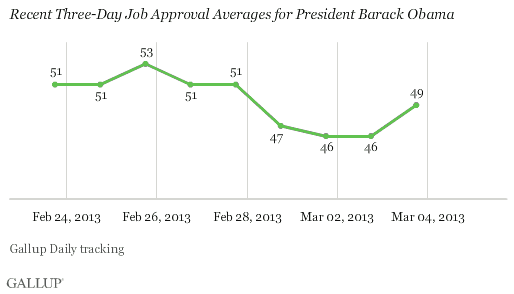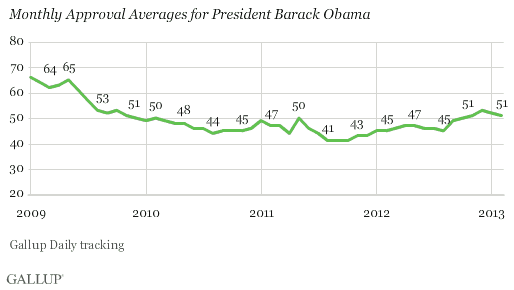PRINCETON, NJ -- President Obama appears to have taken a noticeable, yet brief, hit in public support coinciding with the federal budget sequester that took effect March 1. He averaged 49% approval for the week ending March 3, down from 51% the prior week.

The short-term effect of the sequester on Obama's approval rating is apparent in Gallup's three-day rolling averages.

Obama averaged 51% job approval in Gallup Daily tracking from Feb. 26-28 -- Gallup's three-day average immediately prior to the sequester. The budget sequester went into effect as scheduled on March 1 after Obama and Republican leaders met but did not reach an agreement to delay it. Then, in the first two days of the sequester, March 1-2, Obama's approval ratings were quite a bit lower, bringing his three-day averages for Feb. 28-March 2 and March 1-3 down to 46%.
However, his March 3 and March 4 approval ratings were higher, and Gallup's latest three-day average approval rating -- based on March 2-4 polling -- is 49%, nearly back to Obama's previous level. If the current trend continues, Obama would move back to 50% or above in Wednesday's daily update.
Obama Had Been at or Above 50% Since October
Obama's approval ratings have been consistently at or above 50% for some time. He averaged 51% approval in February, and has been at 50% or higher each month since October. Prior to that, Obama endured a more than two-year stretch with mostly sub-50% approval ratings, beginning in March 2010. The lone exception during that time was a 50% average for May 2011, after U.S. Navy SEALs killed 9/11 mastermind Osama bin Laden in a raid.

On a weekly basis, Obama's approval ratings had been 50% or higher each week since October.
Implications
Gallup Daily tracking allows for unique measurement of the federal budget sequester's impact on Americans' most important political and economic attitudes. In addition to Obama's approval rating, Americans' confidence in the economy has been affected negatively since the forced budget cuts went into effect. Although Obama's approval rating seems to be recovering from a short-term hit, Americans' economic confidence remains down. Gallup's three-day rolling average Economic Confidence Index score for March 2-4 is -27; it has not been lower since last September.
Of course, the sequester has just started, and its biggest effects may not become apparent for a while. Indeed, Gallup finds that half of Americans are currently unsure about the effects of the cuts on the economy and on themselves, personally, though the remainder of Americans are more negative than positive. Thus, while Obama may have recovered from a short-term decline in his public support, his approval rating will likely remain in a precarious state until he and Congress can reach accord on federal spending and the budget deficit.
Explore President Obama's approval ratings in depth and compare them with those of past presidents in the Gallup Presidential Job Approval Center.
Survey Methods
Results are based on telephone interviews conducted as part of Gallup Daily tracking Feb. 25-March 3, 2013, with a random sample of 3,573 adults, aged 18 and older, living in all 50 U.S. states and the District of Columbia.
For results based on the total sample of national adults, one can say with 95% confidence that the margin of sampling error is ±2 percentage points.
Interviews are conducted with respondents on landline telephones and cellular phones, with interviews conducted in Spanish for respondents who are primarily Spanish-speaking. Each sample of national adults includes a minimum quota of 50% cellphone respondents and 50% landline respondents, with additional minimum quotas by region. Landline telephone numbers are chosen at random among listed telephone numbers. Cellphones numbers are selected using random digit dial methods. Landline respondents are chosen at random within each household on the basis of which member had the most recent birthday.
Samples are weighted to correct for unequal selection probability, nonresponse, and double coverage of landline and cell users in the two sampling frames. They are also weighted to match the national demographics of gender, age, race, Hispanic ethnicity, education, region, population density, and phone status (cellphone only/landline only/both, cellphone mostly, and having an unlisted landline number). Demographic weighting targets are based on the March 2012 Current Population Survey figures for the aged 18 and older U.S. population. Phone status targets are based on the July-December 2011 National Health Interview Survey. Population density targets are based on the 2010 census. All reported margins of sampling error include the computed design effects for weighting.
In addition to sampling error, question wording and practical difficulties in conducting surveys can introduce error or bias into the findings of public opinion polls.
For more details on Gallup's polling methodology, visit www.gallup.com.
